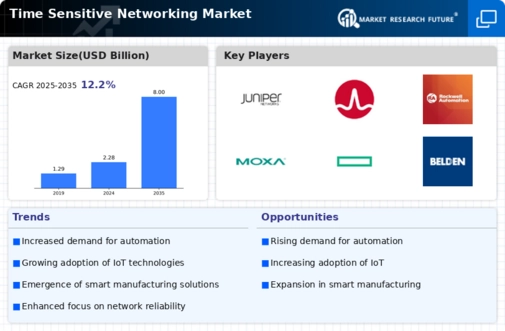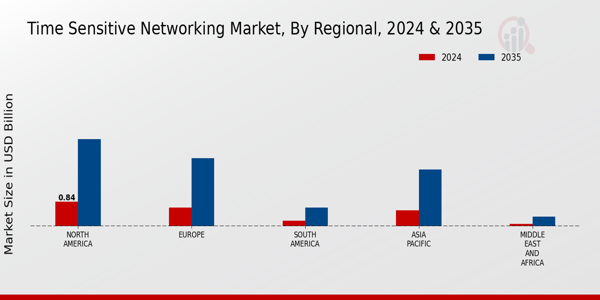Emergence of Smart Cities
The emergence of smart cities is significantly influencing the Global Time Sensitive Networking Market Industry. Urban areas are increasingly integrating advanced technologies to enhance infrastructure, transportation, and public services. Time Sensitive Networking is essential for the seamless operation of smart city applications, such as traffic management systems and public safety networks. As cities strive to improve the quality of life for residents, the demand for reliable and efficient communication networks is expected to grow. This trend is likely to contribute to a compound annual growth rate of 12.09% from 2025 to 2035, as municipalities invest in modern networking solutions to support their smart initiatives.
Market Growth Visualization
Increased Focus on Cybersecurity
Increased focus on cybersecurity is shaping the Global Time Sensitive Networking Market Industry as organizations recognize the importance of securing their networks against potential threats. With the rise of interconnected devices, the risk of cyberattacks has escalated, prompting businesses to adopt more secure networking solutions. Time Sensitive Networking offers enhanced security features that protect sensitive data during transmission, making it an attractive option for industries such as finance and healthcare. As organizations prioritize cybersecurity, the market is likely to benefit from heightened investments in secure networking technologies, further driving growth in the coming years.
Advancements in Industrial Automation
Advancements in industrial automation are propelling the Global Time Sensitive Networking Market Industry forward. With the rise of Industry 4.0, manufacturers are increasingly adopting smart technologies that require reliable and timely data exchange. Time Sensitive Networking plays a crucial role in ensuring that automated systems function optimally by providing deterministic communication. As a result, the market is expected to witness substantial growth, with projections indicating a value of 8 USD Billion by 2035. This trend is further supported by the increasing implementation of IoT devices and smart sensors, which necessitate robust networking solutions to maintain operational efficiency and safety.
Regulatory Support and Standardization
Regulatory support and standardization are pivotal in fostering the growth of the Global Time Sensitive Networking Market Industry. Governments and industry bodies are increasingly recognizing the need for standardized networking protocols to ensure interoperability and reliability across various applications. Initiatives aimed at developing and promoting Time Sensitive Networking standards are likely to enhance market adoption, as organizations seek to comply with regulatory requirements. This supportive environment is expected to facilitate the integration of Time Sensitive Networking solutions across diverse sectors, thereby contributing to the overall market expansion.
Growing Demand for Real-Time Data Processing
The Global Time Sensitive Networking Market Industry is experiencing a surge in demand for real-time data processing across various sectors, including manufacturing, automotive, and telecommunications. As industries increasingly rely on instantaneous data transmission for operational efficiency, the market is projected to reach 2.28 USD Billion in 2024. This growth is driven by the need for low-latency communication, enabling applications such as autonomous vehicles and smart factories. The integration of Time Sensitive Networking technology facilitates seamless communication between devices, thereby enhancing productivity and reducing operational costs. Consequently, the market is anticipated to expand significantly as organizations seek to leverage real-time data capabilities.






















